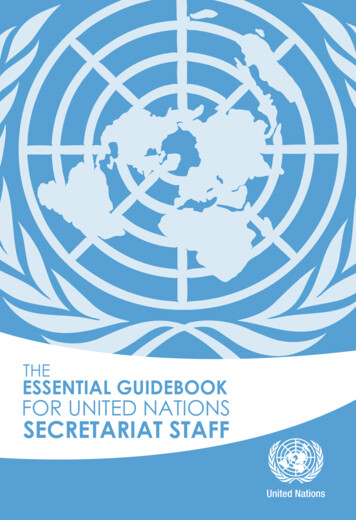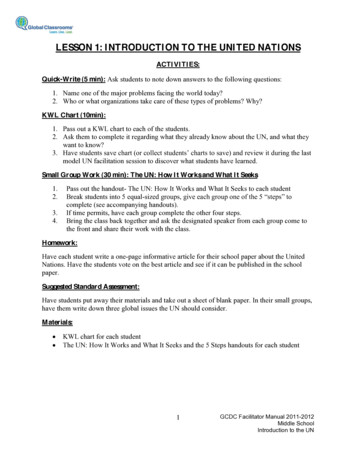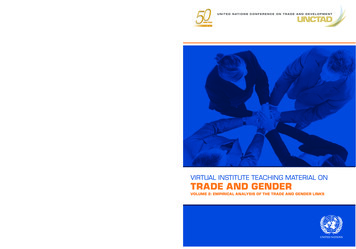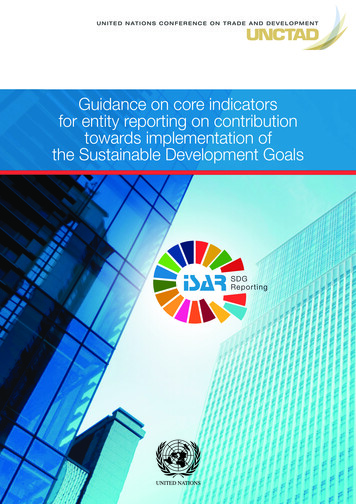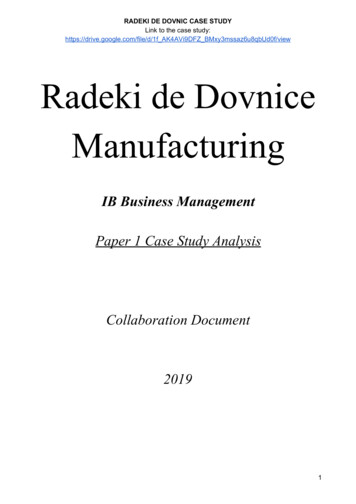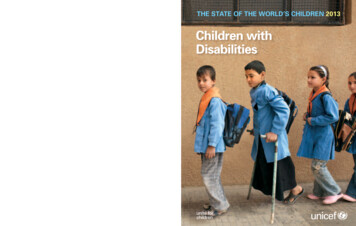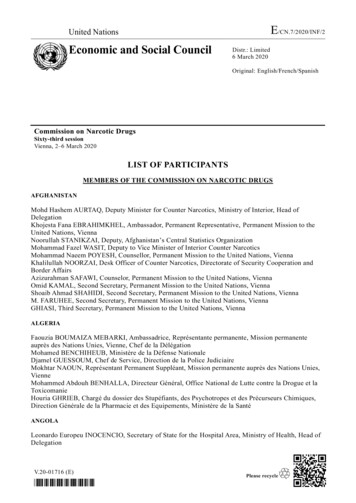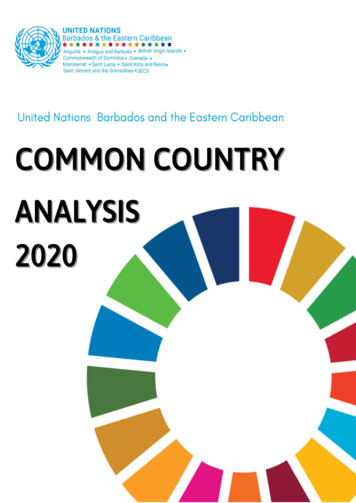
Transcription
Table of ContentsAcronyms and Abbreviations . vExecutive Summary. viii1.Introduction . 1Sub-regional context . 1The 2030 Agenda . 3International norms and standards . 4Commitments to the SDGs. 4Sendai Framework for Disaster Risk Reduction 2015–2030 . 4Paris Agreement on Climate Change . 4Commitments deriving from international human rights instruments and mechanisms . 5The Common Country Assessment (CCA) . 52.Progress towards the 2030 Agenda . 6SDG implementation trends . 6Impact of COVID-19 on SDG progress . 8SDG integration . 10SDG data and monitoring. 10Regional strategies for monitoring SDGs . 10Challenges with SDG data and monitoring . 113.Leaving no one behind . 12Key challenges, their drivers and root causes . 12People living in informal settlements . 12Persons with disabilities. 13LGBTQI persons . 14Persons living with HIV/AIDS . 14Youth (aged 15–24) . 15Children . 17Elderly and other vulnerable groups. 18Migrants and refugees . 19Human rights. 19Administration of justice . 20Progress on international human rights obligations . 20Challenges to the human rights architecture . 21Gender equality and women’s empowerment. 21Sexual and gender-based violence . 22Path to 2030 . 23
4.Multi-dimensional vulnerability risk analysis. 24Risks to peace and security . 24Key challenges, their drivers and root causes. 24Democratic space . 25Path to 2030 . 28Risks to sustainable economic growth. 29Trade volatility, economic growth and stability . 29Climate change and environmental shocks . 29Food security, agriculture and land . 29Economic diversification . 30Path to 2030 . 31Risks to social progress and social cohesion . 31Key challenges, their drivers and root causes. 31Path to 2030 . 38Risks to the environment and climate resilience . 38Key challenges, their drivers and root causes. 39Path to 2030 . 485.Financing sustainable development . 49Economic transformation . 49Existing strategies and policies . 49Opportunities and constraints . 53SDG financing landscape . 53Existing strategies and policies . 53Opportunities and constraints . 546.Institutional gaps, capacity and challenges . 55Governance and institutional capacity . 557.Conclusion . 56Human well-being and capabilities . 56Governance . 56Economy and finance . 57Individual and collective action . 58Science and technology . 60Sustainable and just economies . 61Governance . 61Economy and finance . 62Individual and collective action . 62Science and technology . 62Food systems and nutrition patterns. 63
Economy and finance . 63Individual and collective action . 64Science and technology . 64Energy decarbonisation with universal access . 65Governance . 65Economy and finance . 65Individual and collective action . 65Science and technology . 65Urban and peri-urban development . 65Governance . 65Economy and finance . 65Individual and collective action . 66Science and technology . 66Global environmental commons . 66Governance . 66Economy and finance . 67Individual and collective action . 67Science and technology . 67Annex 1 – Leaving no one behind . IRecommendations (Path to 2030) . IAnnex 2 – Risks to peace and security . VIRecommendations (Path to 2030) . VIAnnex 3 – Risks to sustainable economic growth . VIIRecommendations (Path to 2030) . VIIAnnex 4 – Risks to social progress and social cohesion . IXRecommendations (Path to 2030) . IXAnnex 5 – Risks to the environment and climate resilience . XIRecommendations (Path to 2030) . XIAnnex 6 – Economic transformation - Opportunities and constraints .XVRecommendations .XVAnnex 7 – Economic transformation – SDG financing landscape .XVIRecommendations .XVIAnnex 8 – Institutional gaps, capacity and challenges .XVIIRecommendations .XVIIAnnex 9 – Principles of Effective Governance for Sustainable Development . XIX
List of FiguresFigure 1: Real GDP projections for the Eastern Caribbean, October 2020 . 3Figure 2: Unemployment rates by age group for the Eastern Caribbean. 16Figure 3: Rates of teenage pregnancy in Caribbean countries and averages for LAC (purple) and theCaribbean (green) . 17Figure 4: COVID-19 in a systemic risk scenario in the Caribbean region . 46List of TablesTable 1: SDG progress dashboard for Eastern Caribbean countries. 6Table 2: SDG trends in Eastern Caribbean countries . 7Table 3: Estimates of urbanisation and informal settlement across the Eastern Caribbean . 12Table 4: Drivers of national added value for selected Eastern Caribbean countries as % of GDP* . 49Table 5: Dependence on tourism, remittances and foreign direct investment for selected EasternCaribbean countries, % of GDP, 2019 . 50List of BoxesBox 1: Tackling informal settlements in Saint Lucia. 13Box 2: Positive prison reform results and practices in Barbados and Trinidad and Tobago . 28
Acronyms and AbbreviationsAIArtificial intelligenceCARICOMCaribbean CommunityCCACommon Country AssessmentCDBCaribbean Development BankCDEMACaribbean Disaster Emergency Management AgencyCEDAWConvention on the Elimination of all Forms of Discrimination AgainstWomenCHDRCaribbean Human Development ReportCOVID-19Coronavirus disease 2019CPACountry Poverty AssessmentCRCConvention on the Rights of the ChildCRPDConvention on the Rights of Persons with DisabilitiesCSMECARICOM Single Market and EconomyCSSCARICOM Statistical SystemDRM/DRRDisaster risk management/reductionEbAEcosystem-based adaptationECCUEastern Caribbean Currency UnionECLACEconomic Commission for Latin America and the CaribbeanEEZexclusive economic zoneEWSEarly warning systemFAOFood and Agriculture Organization of the United NationsGDPGross domestic productGHGGreenhouse gasGNIGross national incomeHFLEHealth and Family Life EducationHRWHuman Rights WatchIADB/IDBInter-American Development Bankv
ICTInformation and communications technologyILOInternational Labour OrganizationIPCCInter-governmental Panel on Climate ChangeITUInternational Telecommunications UnionLACLatin America and the CaribbeanLGBTQIlesbian, gay, bisexual, transgender, queer, and intersexLMSLearning management systemLNOBLeave no one behindMICSMultiple Indicator Cluster SurveyMPAMarine protected areaMSMEMicro, small and medium-sized enterprisesNBSNature-based solutionsNCDsNon-communicable diseases (NCDs)NEETNot in employment, education, or trainingNGONon-governmental organisationNHRINational Human Rights InstitutionNSONational Statistical OfficeODAofficial development assistanceOECDOrganisation for Economic Cooperation and DevelopmentOECSOrganisation of Eastern Caribbean StatesOPDsOrganisations of Persons with DisabilitiesPAHO/WHOPan-American Health Organization/World Health OrganizationPLHIVPersons living with HIVPWDsPersons with disabilitiesRIARapid Integrated AssessmentRSDSRegional Strategy for the Development of StatisticsSDGsSustainable Development GoalsSFDRRSendai Framework for Disaster Risk Reduction 2015-2030SLRSea level riseSIDSSmall Island Developing StatesSRH/SRHRSexual and reproductive health/and rightsvi
UNAIDSJoint United Nations Programme on HIV/AIDSUNDESAUnited Nations Department of Economic and Social AffairsUNDPUnited Nations Development ProgrammeUNDRRUnited Nations Office for Disaster Risk ReductionUNECLACUnited Nations Economic Commission for Latin America and the CaribbeanUNEPUnited Nations Environment ProgrammeUNESCOUnited Nations Educational, Scientific and Cultural OrganizationUNFPAUnited Nations Population FundUN-HABITATUnited Nations Human Settlements ProgrammeUNICEFUnited Nations Children’s FundUNODCUnited Nations Office on Drugs and CrimeUN RCOUnited Nations Resident Coordinator’s OfficeUNSTUnited Nations Sub-Regional TeamUNWOMENUnited Nations Entity for Gender Equality and the Empowerment ofWomenUPRUniversal Periodic ReviewVAWGviolence against women and girlsWFPWorld Food Programmevii
Executive SummaryThe availability of timely, disaggregated data across all countries, as well as targets and indicators toinform progress on the Sustainable Development Goals (SDGs) remains a challenge. Nevertheless, aclear picture is emerging of the state of implementation of these Goals within the Eastern Caribbean.Although the region made progress in regard to social indicators, such as the reduction of poverty andinequality, it has slowed or stalled in the past five years. Many people face overlapping structuralconstraints on their ability to cope, including those who are poor and from a minority group. Ruralwomen, the elderly, persons with disabilities, female-headed households, lesbian, gay, bisexual,transgender, queer, and intersex persons (LGBTQI), refugees and migrants also face intersecting formsof discrimination and/or lack of access to services and support. In some cases, laws do not provideprotection, and social protection mechanisms do not adequately respond to the needs of those leftfurthest behind.Violence against women and children is rife across the region, while violent crime due to the activitiesof criminal gangs and the influx of small arms and drugs has risen sharply. Further, the retention ofthe death penalty and the practice of corporal punishment are prevalent throughout the region.Problems in the administration of justice, relating to an inefficient and politicised judiciary, policemisconduct, prison conditions, and juvenile justice are present in virtually all the countries. There arealso concerns regarding human trafficking and freedom of the press. Gender stereotypes prevailacross the Eastern Caribbean on the role and place of women in relation to men, resulting in anundervaluing of women’s work and contribution to national sustainable development efforts. This isa main cause of gender and sex-based discrimination which drives gender inequalities in developmentpolicies as well as service delivery across key sector institutions.At the national level, peace and security are undermined by several factors including high youthunemployment, poverty, educational underperformance, violence in the home and communities, andrisky behaviours. These factors often converge to strengthen the allure of drugs and crime for themost vulnerable, in turn contributing to an assault on peace and security. The situation is furthercomplicated by the geographic position of the sub-region, being vulnerable to organised crime flowsthat tranship guns, drugs, and cash that fuel crime and insecurity at the national level.The region’s heavy reliance on trade has historically contributed to increased employment andreduced poverty, supporting growth. Trade tendencies within the region show a dependence oncritical imports such as food supplies, and input goods for agriculture, energy, industry, and theconstruction sectors. However, trade imbalances have worsened significantly since the 1990s, makingCaribbean economies and food security extremely vulnerable. Transitioning to a sustainable economicpathway will depend on how effectively the sub-region is able to build on its comparative advantageswhile overcoming small size and vulnerability. This can be done by leveraging its natural capital,human endowment, and regional connectivity, and embracing innovation, agility, and newtechnologies for the sustainable expansion of social opportunities.Climate change, environmental degradation and disasters pose a major threat to sustainabledevelopment. Further, environmental shocks will affect the socioeconomic resilience of the poorestand most vulnerable by compromising their access to critical livelihood assets and influencing riskbehaviours as it relates to livelihood decisions, practices, and coping strategies. Fisherfolk and rainfed farmers who incur damage and losses as a result of natural hazards or recurrent or simultaneousshocks, for example, will experience increased difficulty in accessing critical livelihood assets such asfishing gear, seeds, and fertilisers. The lack of access to proper financing or appropriate insurance andlimited social protection systems further increase their sensitivity to these shocks particularly in ruralareas. When pushed to the limit, these poor and highly vulnerable groups can resort to moredesperate livelihood decisions and negative coping strategies such as taking on high-interest loans orviii
engaging in over-exploitation and/or illegal or unsustainable natural resource extractive practices.This could in turn lead to cyclical indebtedness and worsen environmental degradation.The underrated importance of food and nutrition security and food sovereignty hides the connectionbetween the ability to feed the nation, benefits to health and a foundation for sustained growth. Highdependence of the Organisation of Eastern Caribbean States (OECS) and Barbados on food imports,surpassing US 640 million in 2018 and estimated at over US 5 billion for CARICOM states, couldrapidly compromise gains made in the economic development of Caribbean Small Island DevelopingStates (SIDS).Increasing fiscal space for health in a sustainable manner is a major challenge for Caribbean countriesand is heavily dependent on the state of the political economy for health. The health fiscal allocationin national budgets ranges from 6.89 per cent of total government budget in St. Kitts and Nevis to18.08 per cent in Antigua and Barbuda. Out-of-pocket payments (OOP) range from 30.95 per cent oftotal health expenditure (THE) in Dominica to 47.77 per cent in St. Kitts and Nevis.Wide income inequality and high unemployment rates mean that many Caribbean countries have ahigh proportion of the population living below the national poverty line. Women employed in retail,tourism, and services sectors, both within the formal and informal sectors, have been severelyaffected by the slowdown and complete grinding to a halt of these sectors as governments respondto COVID-19 with restrictive measures. Women are more likely than men to work in low-wage jobs,and without social protection, and shoulder a disproportionate burden of unpaid care work as theyattempt to balance the demands of their reproductive and productive roles.Eastern Caribbean countries have largely achieved universal access to primary and secondaryeducation services. However, they continue to struggle to ensure equitable access to a continuum ofinclusive quality learning from early childhood through primary, secondary, and post-secondary levels.Most educational environments are not fully inclusive for all learners – particularly learners withdisabilities (including learning challenges), migrants and other learners with special support needs.Despite the availability of secondary school places, systemic issues, social pressures, and theorganisation and content of secondary education result in real and potential exclusion, especially forboys. Secondary school is generally perceived as not catering to the needs of students and the marketdemands to enable school graduates to play an active role in the economic, social, and politicaldevelopment of themselves and society. The need to adjust the current accepted definition of schoolcompletion from years of school attendance so that it is better aligned with educational achievementis indicative of some of the fundamental challenges in the education sector. Less than half of studentsattain education outcomes to gain entry into tertiary education.In the region, there are different types of social protection instruments. Social insurance, for example,is present in all countries and has been providing long and short-term benefits to workers and theirfamilies in the formal sector. However, of concern is the lack of protection in the case ofunemployment and the ability of social protection systems to scale up in response to a crisis or shock.Despite the proven impacts of social protection programmes and systems, coverage of children andfamilies remains sub-optimal in the region and key challenges remain. These challenges includefragmented programmes, no clear consolidated information or data about the population effectivelycovered by social protection, a lack of evidence produced on the impact of these social protectionprogrammes, and the absence of integrated information systems with wide coverage and systematicmechanisms for collecting up-to-date data.Despite stable governance, a lack of medium to long-term development planning is a common featureacross the sub-region. Public sector capacity is stymied by fragmentation and outdated legal andregulatory frameworks which undermine the performance and responsiveness of civil serviceadministration, public financial management, governance of information and communicationsystems, citizen participation and the business environment. In addition, the Eastern Caribbean facesix
unique challenges in providing services to children and their families, and all countries haveconsiderable work left to do to ensure the full realisation of the rights of children.This Common Country Analysis concludes with over 150 recommendations for action within theEastern Caribbean towards the realisation of the 2030 Agenda for Sustainable Development based onsix entry points for accelerating and scaling the change needed for SDG attainment.x
1. IntroductionSub-regional contextThe Eastern Caribbean has attained relatively high levels of gross domestic product (GDP) per capita,economic growth, financial prosperity, infrastructural development and political stability, whichplaces the countries that comprise this sub-region 1 in the upper middle- and high-income categories(World Bank Country Classification). Simultaneously, there remain high levels of poverty,unemployment, under-utilisation of human capital, institutional capacity weaknesses, inadequategovernment accountability, and gender and social inequities. Although the data on poverty andinequality for Eastern Caribbean states are dated, existing information indicates that poverty levelsremain high across the countries at an average of 24.6 per cent 2 of the population.Countries in the sub-region also share the following common characteristics: Size and geography, the latter predisposing them to natural hazards and climate changeEconomic openness, leading to both economic growth and economic volatilityStrong regional institutions to leverage the challenges of small size by pooling resources(examples include the Eastern Caribbean Currency Union (ECCU), the Eastern CaribbeanSupreme Court, and the Pharmaceutical Procurement Service)Large diasporas: The Organisation of Eastern Caribbean States (OECS) diaspora represents 55per cent of the population re
Figure 1: Real GDP projections for the Eastern Caribbean, October 2020.3 Figure 2: Unemployment rates by age group for the Eastern Caribbean.16 Figure 3: Rates of teenage pregnancy in Caribbean countries and averages for LAC (purple) and the

